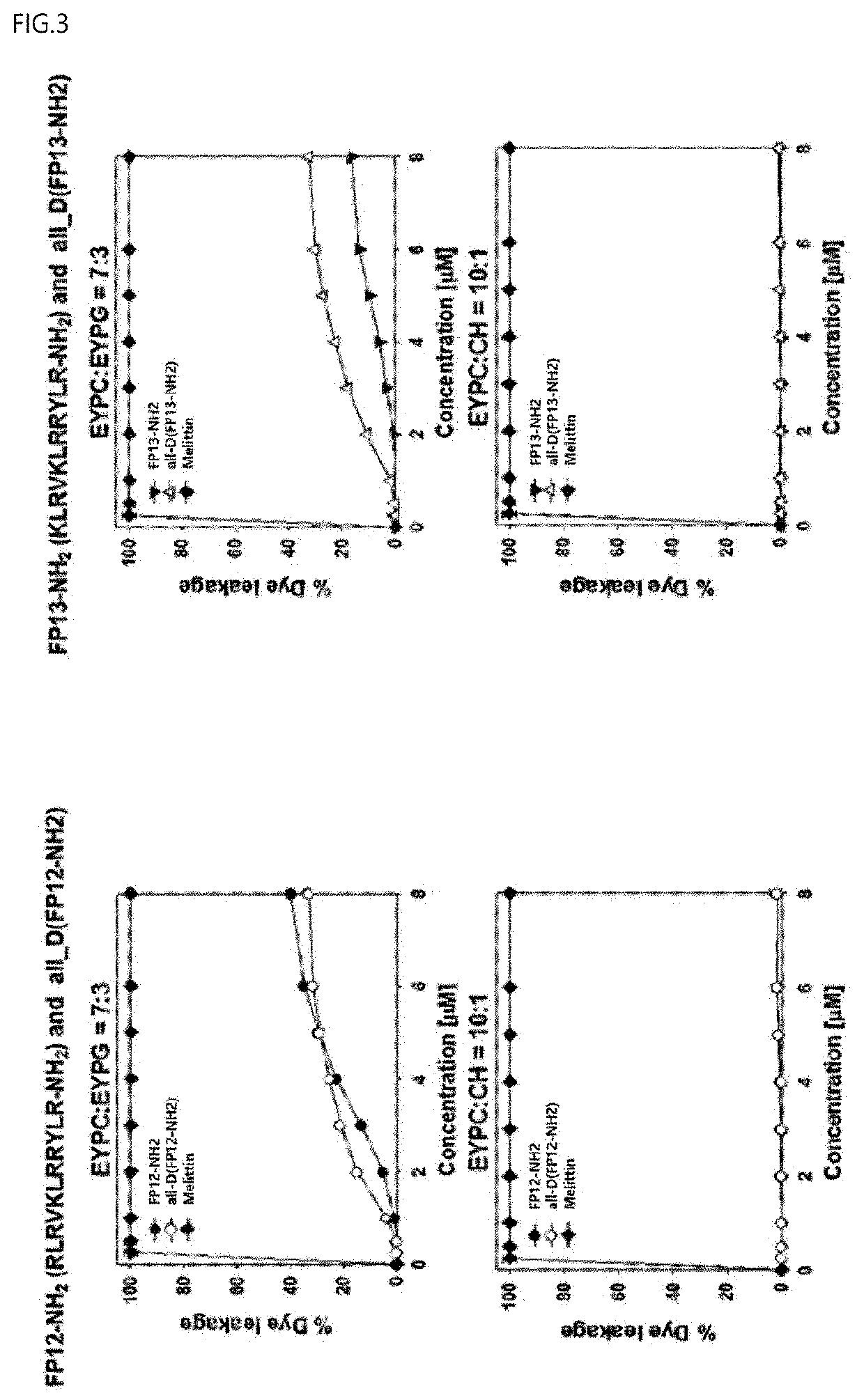Polypeptide having antibacterial activity, composition for preventing or treating sepsis comprising same, and antibacterial composition
- Summary
- Abstract
- Description
- Claims
- Application Information
AI Technical Summary
Benefits of technology
Problems solved by technology
Method used
Image
Examples
example 3
n of Comparison in Antibacterial Activity of Peptides and Three Antibiotics Against Antibiotic-Resistant Bacteria (ESBL and Carbapenem-Resistant Bacteria)
[0364]To analyze the antibacterial activity of 9 types of peptides, the antibacterial activity against bacteria resistant to ampicillin (AMP), imipenem, colistin, and other five antibiotics (ESBL-E. coli, carbapenem resistant A. baumannn, carbapenem resistant Klebsiella pneumoniae, carbapenem resistant Pseudomonas aeruginosa, and colistin resistant Acinetobactor baumannii) was confirmed.
[0365]The antibacterial activity was evaluated according to an antibacterial activity test method for measuring the minimum inhibitory concentration 50 (MIC50; the minimal concentration that kills 50% of bacteria).
[0366]More specifically, 100 μL of a medium was dispensed into each well of a 96-well plate, and in the first column, an antibiotic and a peptide in 200 μL of the medium were dispensed. ½ serial dilution was performed from columns 1 to 11 ...
example 4
nt of Hemolytic Activity of Peptide
[0368]The following experiment was carried out to determine the toxicity of a peptide through measurement of the red blood cell hemolytic activity in a human.
[0369]The red blood cells in a human were diluted with PBS for washing, and centrifuged for 10 minutes, the washing process was repeated three times. The 8.0% red blood cell solution diluted with PBS was loaded into a 96-well microtiter plate by 100 μL and 100 μL of a peptide solution was mixed, the mixture was incubated at 37° C. for 1 hour, and then the 96-well microtiter plate was centrifuged for 5 minutes. A 100 μL of supernatant was taken and transferred to another 96-well microtiter plate, and then absorbance was measured at 405 nm. Here, a value obtained when treated with 0.1% Triton X-100 was calculated as 100% hemolysis, and the hemolytic activity of the peptide was calculated as % hemolysis by Equation 1 below.
Celldisruptionrate(%)Hemolysis)=A-CB-C×100[Equation1]
[0370]Her...
example 5
nt of Secondary Structure of Peptide Using Circular Polarization Dichroism Spectroscopy
[0373]To measure the secondary structure of the FP12-NH2 and FP13-NH2 peptides, an experiment was carried out as follows.
[0374]To study the secondary structure of the peptides in a biomembrane-like environment, the peptides were dissolved in a 0.3 mL solvent such that the concentration of the peptides became 100 μM per sample in an aqueous solution, 100 mM SDS, or 50 mM DPC. 1 mm path length cells were analyzed using a Jasco J-720 circular dichroism spectrophotometer, thereby obtaining an absorption value per 0.1 nm at an injection rate of 100 nm / min, and six injections were averaged, thereby obtaining a measurement value.
[0375]Circular polarization dichroism spectroscopy shows a characteristic absorption pattern depending on the secondary structure of the backbone of a polypeptide. The FP12-NH2 and FP13-NH2 peptides did not have a secondary structure in an aqueous solution, but had two minimal po...
PUM
| Property | Measurement | Unit |
|---|---|---|
| Electrical resistance | aaaaa | aaaaa |
| Acidity | aaaaa | aaaaa |
| Antimicrobial properties | aaaaa | aaaaa |
Abstract
Description
Claims
Application Information
 Login to View More
Login to View More - R&D
- Intellectual Property
- Life Sciences
- Materials
- Tech Scout
- Unparalleled Data Quality
- Higher Quality Content
- 60% Fewer Hallucinations
Browse by: Latest US Patents, China's latest patents, Technical Efficacy Thesaurus, Application Domain, Technology Topic, Popular Technical Reports.
© 2025 PatSnap. All rights reserved.Legal|Privacy policy|Modern Slavery Act Transparency Statement|Sitemap|About US| Contact US: help@patsnap.com



